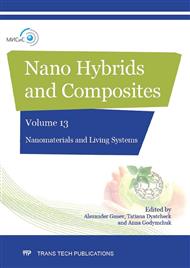p.301
p.309
p.316
p.323
p.330
p.334
p.341
p.348
p.355
Preparation of TiO2/Carbon Nanotubes Composites and a Study of their Adsorption on Organic Dyes
Abstract:
In this paper, the results of experimental studies on the preparation and determination of adsorption characteristics of nanomodified titanium dioxide (TiO2) are presented. A commercially available TiO2 powder was used as starting material. The nanomodification process consisted in the synthesis of carbon nanotubes (CNTs) by chemical vapor deposition over a TiO2 sample in a batch reactor. The presence of the CNTs at the surface of that sample was confirmed by thermogravimetry, scanning electron microscopy, and Raman spectroscopy. To estimate adsorption parameters of the pristine (non-modified) and nanomodified materials, kinetic experiments on the adsorption of an organic dye, methyl orange, were conducted. It was found that the adsorption capacity of the nanomodified sample reaches its maximum value 1.5 times faster than that of the pristine one. The kinetics of the adsorption process was studied based on the following models: internal diffusion, pseudo-first-order, pseudo-second-order, and Elovich. Considering the calculated values of correlation coefficients obtained for those models, it can be assumed that the adsorption is satisfactorily described by the pseudo-second-order equation.
Info:
Periodical:
Pages:
348-354
Citation:
Online since:
January 2017
Price:
Сopyright:
© 2017 Trans Tech Publications Ltd. All Rights Reserved
Share:
Citation:


